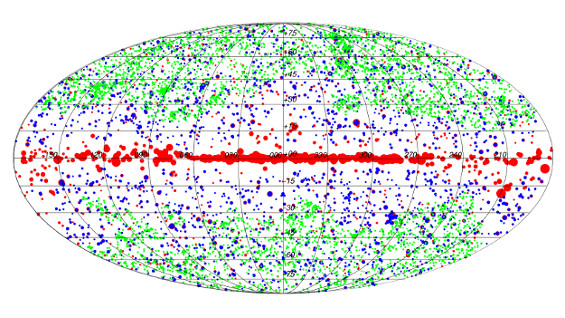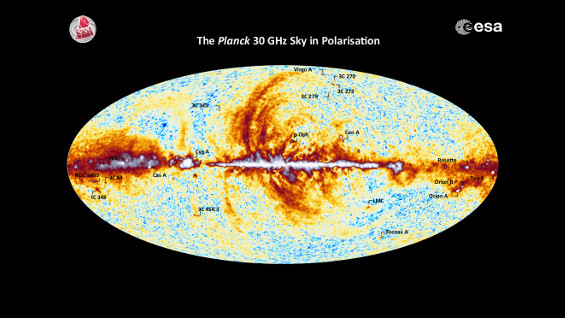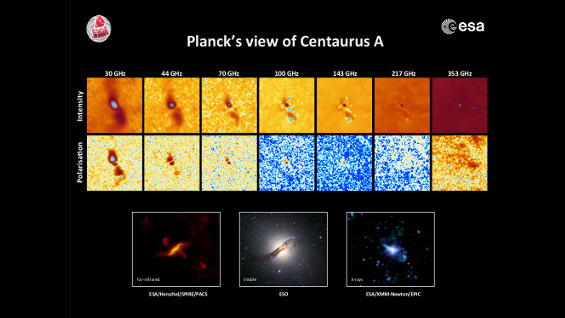New Tool for Astronomers – Second Planck Catalogue of Compact Sources Released
9 July 2015
ESA's Planck mission is the source for a new catalogue, eagerly awaited by the scientific community, and available online from today. The Second Planck Catalogue of Compact Sources uses data from the entire mission to identify tens of thousands of compact sources, as well as providing polarisation data for several hundred of them. The new catalogue surpasses its predecessors not only in the quantity of sources but also in the quality of data. It will be an asset to astronomers working in a wide range of fields.ESA's Planck telescope set out to measure tiny fluctuations in the Cosmic Microwave Background (CMB) – the thermal footprint left by the Big Bang. To achieve this, it continuously scanned the sky between 2009 and 2013, detecting the CMB as well as the foreground emissions arising from cosmic structures lying between the CMB and ourselves. The study of these foreground structures, which had to be carefully mapped and characterised in order to be separated from the CMB, has resulted in a valuable by-product: an extensive catalogue of tens of thousands of individual compact sources, released today. These sources appear to Planck as bright point-like spots superposed on wide expanses of more diffuse emission and consist mainly of galaxies located at great distances from the Milky Way, though compact objects within our Galaxy also appear in the catalogue.
 |
| Map of selection of compact sources from the Second Planck Catalogue of Compact Sources. Credit: ESA and the Planck Collaboration |
ESA has released compact source catalogues from Planck in the past but in this instance the diverse and extensive catalogue includes data from the full Planck mission. The mission involved surveying the entire sky in nine different wavelengths spanning the far-infrared to radio, covering the spectral range 30 GHz to 857 GHz. The result is a catalogue with datasets from five surveys using the telescope's High Frequency Instrument (HFI) channels and a remarkable eight surveys using the Low Frequency Instrument (LFI) channels. This is a significant leap forward from the one and a half surveys used for the Early Release Compact Source Catalogue, released in 2011, and the 2.5 used in the 2013 catalogue that followed.
"There are a number of ways in which the data in this catalogue surpass those of its predecessors in more than just quantity," explains Marcos López-Caniego from ESA, responsible for the LFI portion of the survey. "For example, for the LFI channels, which cover the frequency range 30 to 70 GHz, averaging data over eight surveys has dramatically increased the sensitivity."
"Another major advance is in the better understanding of the contents of the catalogue," adds Diana Harrison from the Institute of Astronomy, University of Cambridge, UK, who was responsible for the HFI section of the catalogue. "One of the major complications at the wavelengths that Planck observes is to distinguish truly compact individual sources from variations in the diffuse emission which arises from gas and dust in our own Galaxy. In this catalogue there has been a totally new treatment of the reliability of the sources, especially in the HFI channels, which has resulted in much higher confidence in its contents."
The improvements to the reliability and sensitivity of the data are just part of the reason that this extensive database differs from those that came before. Planck has polarisation sensitive instruments in seven of the nine frequencies it observes in and this catalogue, unlike its predecessors, offers polarisation data for several hundred compact sources.
"For those sources that have been significantly detected in polarisation maps we have used the latest calibration of Planck data, and improved pipelines, to measure the polarised flux densities of the sources," explains Marcos. "In other words, we have measured and included the amount of polarised light we have collected radiating from these sources, which means that they can be studied in both total intensity and polarised light."
 |
| Data from the Second Planck Catalogue of Compact Sources are used to map polarised compact sources across the sky, in this example from the 30 GHz channel. Credit: ESA and the Planck Collaboration |
Catalogue use and applications
The catalogue can be accessed from the ESA Planck Legacy Archive hosted at ESA's European Space Astronomy Centre (ESAC) and is available to all researchers. Data are provided in standard fits format tables that can be used with a variety of astronomical tools. A search tool allows users to search by coordinate or common name.
"The catalogue is built with flexibility in mind due to the wide variety of astronomical objects that are contained within it," explains Jan Tauber, Planck Project Scientist at ESA. "The menagerie of sources in the catalogue includes radio galaxies, blazars, infrared-luminous galaxies, galaxy clusters, supernova remnants, cold molecular cloud cores, stars with dust shells, as well as many other unidentified objects, and the list of fields within astronomy which could benefit from the catalogue is just as long!"
The availability of a much larger catalogue of compact sources than has previously been available is of great value to researchers working on other CMB experiments. These sources sorely contaminate CMB data and with the aid of the new catalogue they can now be quickly identified, and removed from, observation data.
As well as the use in CMB research the catalogue will be of use to radio astronomers as it extends the range of frequencies currently available from ground-based telescopes, widening the scope of their research and potentially allowing them to study the emission from their chosen galaxy at nine frequencies with polarisation data in seven channels.
 |
| Detailed view of Centaurus A as seen by Planck. Credit: ESA and the Planck Collaboration |
Researchers from across astronomy – including optical, infrared, radio, X-ray and gamma ray astronomers – will benefit from the catalogue, which can be used to build spectral energy distribution plots of individual objects or whole classes of objects. In other words, plotting the brightness of objects, over a range of frequencies, giving valuable clues to their properties. For others, a key benefit of the catalogue will be the ability to combine its full mission maps and single survey maps with the new tools in the Planck Legacy Archive to produce maps from specific periods of time. This will allow for long-term and short-term studies of how the objects vary over time.
Astronomers looking at far-infrared wavelengths will find the catalogue of particular use, on account of Planck having two channels in common with ESA's Herschel telescope, which provides maps of many of these sources with much higher resolution.
In order to serve the needs of this hugely varied community of users the catalogue includes four different measures of the amount of polarised light, and total intensity, for each source – each measure determined using a different photometry method – so that the user can choose the one most suitable for their needs.
A hint at the potential of the catalogue is evidenced by some results that have already emerged from earlier targeted searches for specific compact sources. Researchers using the 2013 catalogue found in the Planck maps the location of potential precursors of the vast galaxy clusters that we see in our local Universe, and used Herschel to map those sources in detail, confirming a subset of them.
These are just some of the applications that the new catalogue might have and even more are expected to emerge.
"What we are releasing here is an important product of the Planck mission," Tauber comments. "This suite of compact sources represents a lasting legacy that we are confident will produce new and exciting findings across the breadth of astronomy research."
Background Information
Launched in 2009, Planck was designed to map the sky in nine frequencies using two state-of-the-art instruments: the Low Frequency Instrument, which includes three frequency bands in the range 30–70 GHz, and the High Frequency Instrument, which includes six frequency bands in the range 100–857 GHz. HFI completed its survey in January 2012, while LFI continued to make science observations until 3 October 2013, before being switched off on 19 October 2013.
The Planck Scientific Collaboration consists of all the scientists who have contributed to the development of the mission, and who participate in the scientific exploitation of the data during the proprietary period. These scientists are members of one or more of four consortia: the LFI Consortium, the HFI Consortium, the DK-Planck Consortium and ESA's Planck Science Office. The two European-led Planck Data Processing Centres are located in Paris, France and Trieste, Italy. The LFI consortium is led by N. Mandolesi, ASI, Italy (deputy PI: M. Bersanelli, Universita' degli Studi di Milano, Italy), and was responsible for the development and operation of LFI. The HFI consortium is led by J.L. Puget, Institut d'Astrophysique Spatiale in Orsay, France (deputy PI: F. Bouchet, Institut d'Astrophysique de Paris, France), and was responsible for the development and operation of HFI.
Contact Information
Diana Harrison
Institute of Astronomy, University of Cambridge, UK
Tel: +44 1223 766 660
Email: dlh![]() ast.cam.ac.uk
ast.cam.ac.uk
Marcos López-Caniego
ESA European Space Astronomy Centre (ESAC), Madrid, Spain
Tel: +34 91 813 1481
Email: Marcos.Lopez.Caniego![]() sciops.esa.int
sciops.esa.int
Jan Tauber
ESA Planck Project Scientist
Scientific Support Office
Directorate of Science and Robotic Exploration
ESA, The Netherlands
Tel: +31 71 565 5342
Email: jtauber![]() cosmos.esa.int
cosmos.esa.int



